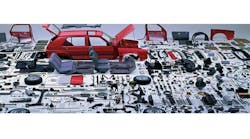Logistic departments of equipment manufacturers should pay attention to the Internet of Things (IoT), according to Ralph Rio of ARC Advisory Group. He cites three reasons for this:
- The underlying technologies are available with no needed breakthroughs.
- Major companies such as IBM, Cisco, GE have IoT programs with product development and marketing campaigns.
- The potential business benefits for OEMs and end users are strong. The technology could help end users improve equipment reliability and reduce spare parts inventories, and help OEMs sell more services at higher margin.
Rio points out that IoT-enabled condition monitoring, spare parts, and equipment repair services, will allow OEMs to remotely monitor asset health in their customers’ plants, anticipate failures, order the parts, and often execute repairs before the failure occurs.
Looking at the overall impact of IoT on logistics and spare parts supply chains, Rio says:
Currently, many spare parts supply chains are constructed in such a manner that inventory is held centrally, perhaps in a manufacturing plant or a centrally located warehouse in a particular region. This central stocking location sends inventory to a network of depots that can provide a quick response to customers’ needs. Often, warehousing and shipping services are outsourced to a third-party logistics (3PL) service provider, particularly the large 3PLs that have specialized in parcel deliveries (FedEx, DHL, TNT, UPS,) and have an infrastructure in place to respond quickly.
Some types of spare parts are not critical in the sense the customer will not lose substantial amounts of money for downtime if the delivery is delayed a few days. An example would be automotive parts or large household appliances parts. However, the ability to deliver quickly to local dealers is a competitive advantage for the manufacturer.
For critical spare parts (such as expensive parts used in production machinery), the customer may have a service contract that requires delivery within a set time period after a service failure occurs. Customers pay more if they require very quick service within a few hours of a part failure. The customer may also pay to install the spare part. If installation services are required, the local depot serving that customer is more likely to be run by the manufacturer, rather than a 3PL.
Clearly if the customer is using a “run to failure” maintenance strategy, which is often the case, the pressure for a satellite depot to respond quickly after a part failure is greatly increased. Critical parts absolutely need to be in inventory in the local depot for the OEM to be able to respond within a few hours.
For less critical parts, it is often impossible for OEMs to store all inventory locally. In automotive, for example, customers may have cars that are decades old, involving potentially hundreds of thousands of different parts. To support dealers, OEMs would have to use expensive overnight shipments from the central warehouse directly to the dealer or to the depots that support the dealer network.
Read more on IoT's effect on spare parts supply chains.



